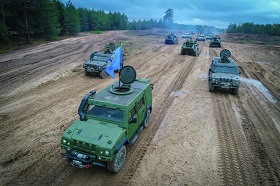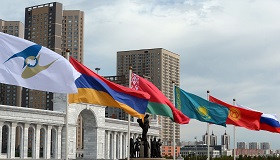The main reason why Pavel Kandel’s forecasts (Evolution of Post-Soviet Space: Past, Present and Future: An Anthology, 2017) have panned out is not that some of the results of his analysis generally coincided with how the situation developed, but instead because of how he formulated questions and his choice of angles.
Even now, it is difficult to predict what Moldova will be like in 2021, which means it must have been an even more mind-boggling task when Kandel made his forecasts. The balance of forces in Moldova changed significantly in June 2019, when the country’s key political figure was removed from office, and in a much more painless way than anyone could have expected. We are talking, of course, about Vladimir Plahotniuc, who was forced to leave the country. He has been spending his days ever since in the United States. With this move, Moldova demonstrated that external intervention is still possible in post-Soviet states and that it can even be positive, resulting from an international consensus.
Moldova is most likely in for a protracted crisis, but the factors mentioned above will only partially cause it. The main problem has to do with the imperfect and weak institutions and the underdevelopment of civil society. It is no coincidence that Plahotniuc effectively ruled the country for many years: it is a fairly common scenario for a weak state to be replaced in terms of its functions by mechanisms that may be more efficient but are by no means more beneficial for society and which do not have long-term prospects.
For years, Plahotniuc played a stabilizing role in domestic affairs, albeit mostly in the negative sense. That said, his removal from politics does not automatically mean that new and brighter prospects will open for Moldova. The internal split and the duality of social structures demand a resolution more than ever before, but there is no obvious solution in sight. Similarly, the problem of ineffective state institutions cannot be resolved quickly, as there are no universal mechanisms by which to do this. The partially ruined mechanisms of political corruption may be replaced by new ones, and new actors may emerge. The worst part of it, however, is the impotence of the authorities, which stems from the inability of any political force to concentrate actual power in its hands and from the exhausted reserves of compromises among the rivalling forces. This is perhaps the main and most difficult challenge for Moldova’s future.
The main reason why Pavel Kandel’s forecasts (Evolution of Post-Soviet Space: Past, Present and Future: An Anthology, 2017) have panned out is not that some of the results of his analysis generally coincided with how the situation developed, but instead because of how he formulated questions and his choice of angles.
Even now, it is difficult to predict what Moldova will be like in 2021, which means it must have been an even more mind-boggling task when Kandel made his forecasts. The balance of forces in Moldova changed significantly in June 2019, when the country’s key political figure was removed from office, and in a much more painless way than anyone could have expected. We are talking, of course, about Vladimir Plahotniuc, who was forced to leave the country. He has been spending his days ever since in the United States. With this move, Moldova demonstrated that external intervention is still possible in post-Soviet states and that it can even be positive, resulting from an international consensus.
According to Kandel’s forecasts, serious political change was not supposed to take place in Moldova until 2021. Indeed, irrespective of the reshuffles in the corridors of power, Moldova has, over the past quarter of a century, pursued a multi-vectored foreign policy. However, the outward stability, which could not be undermined by Plahotniuc’s removal from the picture and the previously unimaginable alliance between the right and the Socialists, cannot hide the institutional weakness and poor governability of the country, the numerous social and economic problems, the polarization of political forces and complicated relations with all of Moldova’s foreign partners. These factors create objective preconditions for destabilization and a radical change in the country.
The Priority of the European Vector
Moldova’s relations with the European Union continue to be a key factor in its prospects for the future. Economic trends and public opinion polls do not suggest that the signing of the Association Agreement with the European Union has had any positive effect on the country’s development. However, the forecast is right to stress that whatever political changes do take place with regard to Moldova's political situation, it is improbable that this will push the country's economy towards Russia and the Eurasian Economic Union (EAEU). The main question in Moldova’s relations with the European Union at present is whether the country’s leadership is prepared to reform the political system effectively and whether the European Union is prepared for dialogue with all the Moldovan political forces, rather than continuing its strategy to cold-shoulder the Socialists led by President Igor Dodon.
According to the forecast, to develop relations with Russia, Dodon has to consolidate the left-wing forces, which is hampered by complex inter-party relations and the leadership ambitions of individual politicians. Until recently, however, consolidating the left-wing forces has proved to be an impossible task because actual power in the country was concentrated in the hands of the oligarch Plahotniuc.
As for Moldova’s relations with Romania, the forecast proved equally correct in the sense that the two countries have failed to merge into a Greater Romania and are highly unlikely to do so in the foreseeable future. However, it could still happen in the long run. In recent years, Romania has tended to view Moldova primarily as a “grey area” country outside the European Union and a potential target for an economic takeover. The Romanian elite benefits from the fact that the country shares a common history and political culture with its neighbour, which is easily malleable, open to investments and at the same time free from EU regulations.
For some Moldovan politicians and citizens, the country’s independence is not an objective but rather a historical problem that needs to be resolved by becoming a part of Romania. The Maia Sandu coalition government, which came to power in 2019, openly advocated this scenario, but there will be too many obstacles to this in the near future. In addition to the unresolved Transnistria dispute, some Moldovan elites are concerned that they could lose their status and turn into a weak regional force. Despite the domestic political changes in the first half of the 2020s, we should expect a new wave of Romanization and deeper integration of the economies of the two countries. The only thing that could stall this process somewhat would be to concentrate power in the hands of President Dodon.
There are certain preconditions for dialogue even between Romania and Transnistria, given the interest of Romanian investors and authorities in Transnistrian assets, mainly in the Kuchurgan power station on the left bank. The Transnistrian leadership is likely to be more inclined towards concessions in the face of the economic blockade that is set to intensify in the near future and may even exacerbate the political situation.
One of Moldova's most pressing problems is ongoing depopulation. Those in favour of integration with Romania will argue that Moldova on its own cannot fight this problem, which is partially true. Another serious argument in favour of integration is the fact that the Moldovan market is objectively small, unable to attract the interest of major investors. This, in turn, means that the country has found itself on the side-lines of innovation. On the whole, we can predict that Moldova’s drive towards closer ties with Romania will intensify in the next few years.
A Country with a Frozen Conflict
The forecast devotes a great deal of space to the Transnistria issue. The author correctly identifies the attempts of the European Union to “tame” Transnistria, Russia’s declining share in Transnistrian exports and the growing role of Moldova and Romania.
The author predicts an aggravation in the current “trench war,” but notes that the sides are not in a position to take more radical steps. Indeed, this is precisely how the situation has been developing up until now, but in the long run, we should expect serious changes in Moldova's relations with Transnistria. It is essential to understand that the future of Transnistria has always depended on external factors: the preservation of the Russian ammunition depot in the village of Cobasna; Ukraine’s desire and ability to influence Transnistria and use it as a way to irritate Russia; Russia’s readiness to provide economic assistance to Transnistria; the European Union’s economic policy and its ability to control Transnistrian exports; and, finally, Moldova’s desire to maintain the status quo.
The interests of the business elites in Moldova and Transnistria are much closer than political news bulletins might suggest. These interests involve income from trafficking, mining, non-payment of Russian gas supplies to Transnistria, etc. Relations between the people of Moldova and Transnistria are well developed. Many Transnistrian residents hold Moldovan passports, including over 240,000 people who have the right to vote in Moldovan elections.
Therefore, it would be wholly inaccurate to say that relations between Moldova and Transnistria need repairing, international efforts and reforms to the state system. Simply put, the only reason that Transnistria continues as a self-governed territory is because its current status suits its population, local elite and external actors. It would thus be wrong to propose federalization as a way out of the current deadlock, for the simple reason that there is no deadlock. This is also because federalization would be unacceptable in the current climate to all of the country’s political forces, even though President Dodon may publicly state the opposite.
In the near future, perhaps even before 2021, the Transnistria situation will be influenced by the success or failure of the Moldovan reforms, the revision of the unofficial agreement between the Moldovan and Transnistrian elite, Transnistria’s relations with Romania and Russia’s eagerness to maintain the status quo both economically and in terms of its presence in the unrecognized territory. The latter factor is debatable: Russia and Moldova are already discussing the possibility of withdrawing Russian ammunition from Transnistria. This process could take several years, after which Russia would find it hard to justify the presence of its troops in the region. International pressure on Russia to withdraw its forces will likely increase in this case.
Possible Coalitions
Unfortunately, the forecast does not include an analysis of the political development trends in Moldova and possible scenarios for various coalitions and rivalries, despite the fact that these trends gave rise one of the main political sensations in the post-Soviet space over the past year. It has long been clear that the situation would continue to escalate as the presidential and parliamentary elections neared, that street protests similar to those seen in 2016 were possible (they were eventually avoided) and that the right-wing forces had everything to lose because another electoral defeat for their leaders would see them exit politics for good.
As is known, the situation was resolved in the following way: the opposing sides met, and the Socialists forged an alliance with the pro-Western bloc ACUM. The coalition did not even last for half a year because it never had a serious foundation and was riddled with contradictions and opportunities for rivalry between the three parties.
The Sandu government’s defeat in the November 2019 elections and the ascent to power of the minority government led by Ion Chicu was not the finale of the drawn-out political process, but rather a prelude to more ambitious changes. They could include constitutional reform and a revision of the president's powers; a new format of interaction between Moldova and Transnistria; the emergence of new leaders across the political spectrum, etc. All these processes will be accompanied by infighting that is far more heated than has ever been seen before, as well as by an open rivalry between the great powers – although this rivalry never actually stopped, even during the June consensus.
Moldova is most likely in for a protracted crisis, but the factors mentioned above will only partially cause it. The main problem has to do with the imperfect and weak institutions and the underdevelopment of civil society. It is no coincidence that Plahotniuc effectively ruled the country for many years: it is a fairly common scenario for a weak state to be replaced in terms of its functions by mechanisms that may be more efficient but are by no means more beneficial for society and which do not have long-term prospects.
For years, Plahotniuc played a stabilizing role in domestic affairs, albeit mostly in the negative sense. That said, his removal from politics does not automatically mean that new and brighter prospects will open for Moldova. The internal split and the duality of social structures demand a resolution more than ever before, but there is no obvious solution in sight. Similarly, the problem of ineffective state institutions cannot be resolved quickly, as there are no universal mechanisms by which to do this. The partially ruined mechanisms of political corruption may be replaced by new ones, and new actors may emerge. The worst part of it, however, is the impotence of the authorities, which stems from the inability of any political force to concentrate actual power in its hands and from the exhausted reserves of compromises among the rivalling forces. This is perhaps the main and most difficult challenge for Moldova’s future.








